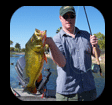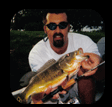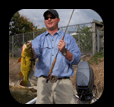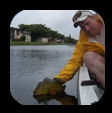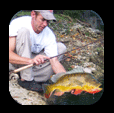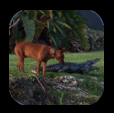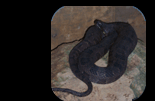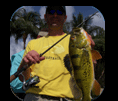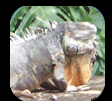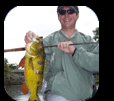Peacock
Bass
Peacock bass Fishing
Florida Peacock Bass Fishing With Capt Mark Hall
DESCRIPTION--Tamiami
Canal (C-4) is located in Miami-Dade County. It drains eastward
from Water Conservation Area III past Miami International
Airport to a non-navigable salinity control structure that prevents
saltwater intrusion from the Atlantic Ocean. Tamiami Canal
provides excellent freshwater fishing in more
than 27 miles of boat accessible canals and small lakes.
The canal ranges from 40 to over 100 feet in width, averages
about eight feet deep, and some lakes are more
than 50 feet deep.
The lakes near Miami International
Airport are often noisy and congested on weekends, but this
area can be avoided by traveling west. From the boat ramp,
it is 3.0 miles to the entrance of the Coral Gables Canal,
4.8 miles to the lateral canal connecting to McDonald Lake,
and 7.6 miles to the intersection with Snapper Creek(immediately
east of the Turnpike Extension). The non-navigable flood control
structure on Tamiami Canal near Krome Avenue is approximately
13 miles from the boat ramp. The combination of Tamiami and
Snapper Creek canal systems provide urban anglers more
than 43 miles of exciting fishing opportunities.
BOAT RAMP DIRECTIONS--The only
public boat ramp is located in Antonio Maceo Park. This park
is open from dawn to dusk, and is operated by the City of Miami
Parks and Recreation Department. The two-lane ramp is paved
and in excellent condition. The park has picnic tables, grills,
a playground, and a paved parking area, but there are no restrooms.
Note: Manatees are quite common, so be careful boating and
watch for posted regulations.
To reach the boat ramp, take the Turnpike Extension
or I-95 to Hwy 836 (Dolphin Expressway). Take Hwy 836 east
from the Turnpike or west from I-95 to Red Road (NW 57th Avenue).
Go south on Red Road about 0.5 miles to NW 7th Street, east
(left) 0.6 miles to NW 51st Avenue, and Antonio
Maceo Park is on the left side just before NW 51st Avenue.
FOOD AND GASOLINE--There are
some service stations and fast food restaurants with restrooms
on the south side of SW 8th Street (Tamiami Trail)
that can be seen by anglers in a boat; many are also conveniently
located along the land route to the boat ramp.
GENERAL FISHING INFORMATION--Tamiami
Canal offers some of the most exciting and varied canal fishing
in all of southeast Florida. Several anglers have reported
canal 'trifecta' or 'grand slam' catches of butterfly peacock
and largemouth bass topped-off with a snook or even a tarpon.
The butterfly peacock is a world renown gamefish that was successfully
introduced in the mid-1980s by the Florida Fish and Wildlife
Conservation Commission to eat undesirable exotic fishes, and
to provide more sportfishing for anglers in the metropolitan
Miami-Ft. Lauderdale area.
Fallen trees, canal intersections, sharp bends,
and dead ends are generally productive areas for catching most
species of fish. Sportfishes also congregate in the shade of
bridges, culverts, and other structures. Shoreline vegetation,
rip-rap, and even some residential seawalls (particularly in
lateral canals) also provide good fishing opportunities. If
there is a strong current in the main canal, spend more time
fishing lateral canals, small lakes, and other areas that offer
refuge from the current (e.g., cut-outs, bridge pilings, and
the downstream side of spillways).
Tamiami Canal supports excellent populations of
butterfly peacock and largemouth bass that average about 14
inches (1.5 pounds), and nearly 50% of the harvestable butterfly
peacock and 40% of the largemouth bass are larger than this.
The biggest butterfly peacock (10 pounds) ever confirmed in
Florida came from this canal. The bag limit for butterfly peacock
is two fish per day, only one of which can be greater than
17 inches; up to five largemouth bass can be kept, but only
one of these can be greater than 14 inches.
Fishing for butterfly peacock is usually best
from March through May, but they are caught consistently throughout
the year. Butterfly peacock feed only during daylight and normally
close to shore, although schooling peacocks will sometimes
feed aggressively in open water. Largemouth bass
fishing tends to be best during the winter when the water
cools, and early in the morning, evenings, and even at night
during the summer.
Butterfly peacock are more likely to be caught
using live fish for bait than are largemouth bass, which make
them an excellent fish for younger anglers, as well as those
just learning to bass fish. Live fish such as small golden
shiners purchased at local tackle shops, are the best overall
bait for both butterfly peacock and largemouth bass. It is
illegal to use goldfish or any other non-native fish for bait,
except those legally caught from and immediately used in the
same canal. For those who enjoy fishing with artificial lures,
just about any fast moving minnow
imitating plug or fly can be used to entice a peacock.
Early in the morning look for tarpon rolling at
the surface, especially in the area just east of Red Road.
Snook can be found throughout the canal system but tend to
concentrate along vegetated shorelines and under bridges close
to lake areas. Another species anglers might catch resembles
a walleye; this fish is the brackish water bigmouth sleeper
which is a long, cylindrical fish with many small sharp teeth.
The number and quality of panfish over six inches
in Tamiami Canal is about average for area canals. Live worms
and crickets are the choice baits for many panfish anglers,
although fresh bread or bread dough works well, is readily
available, and it costs less. Shoreline anglers will need to
do some exploring to find the best locations for shoreline
fishing, and always be sure to park cars safely on public right
of ways.
Tamiami Canal anglers might also catch a jaguar guapote
from Central America, oscars from South America, or spotted
tilapia from Africa. These exotic fishes were illegally released,
and pose a threat to native species. Jaguar guapotes
resemble a black crappie (speckled perch) with many small,
sharp teeth. Oscars are a bream-shaped fish with a red or orange circle
at the base of the tail, and they have a thick coat of protective
mucus on their bodies. Spotted tilapia are also bream-shaped,
golden in color with black spots or bars, and some adults have
red on them. These exotic fishes are good to eat, and you can
keep every one you catch.
Tamiami and other area canals receive a great
deal of fishing pressure so we encourage anglers to release
most, if not all of the butterfly peacock, largemouth bass,
snook, and tarpon they catch. If anglers don't release a majority
of the sportfish they catch, these high quality fisheries will
deteriorate rapidly.
|


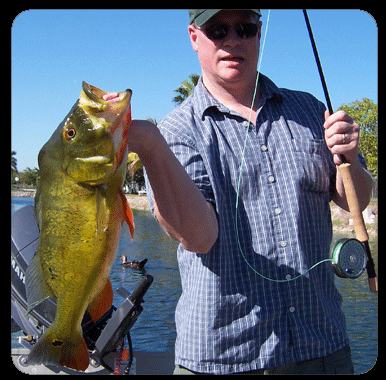

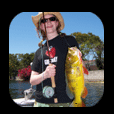


![]()
